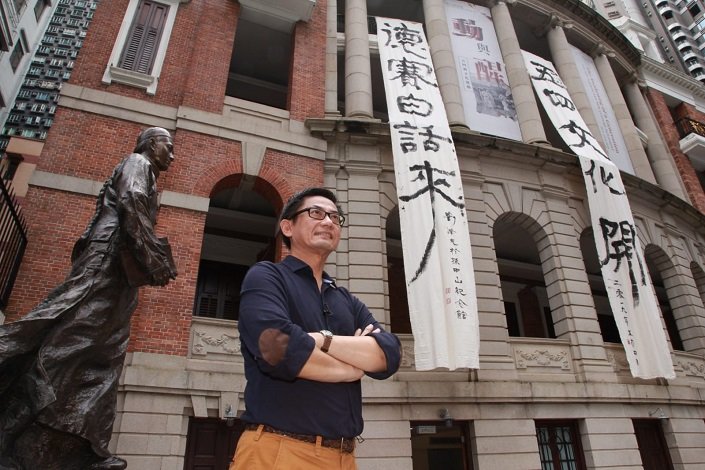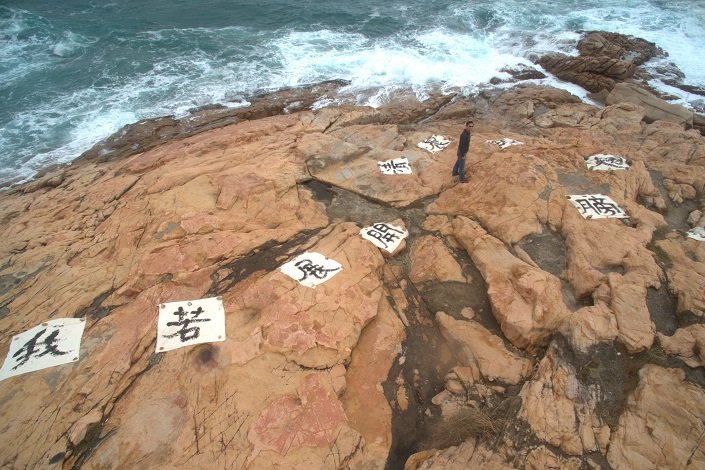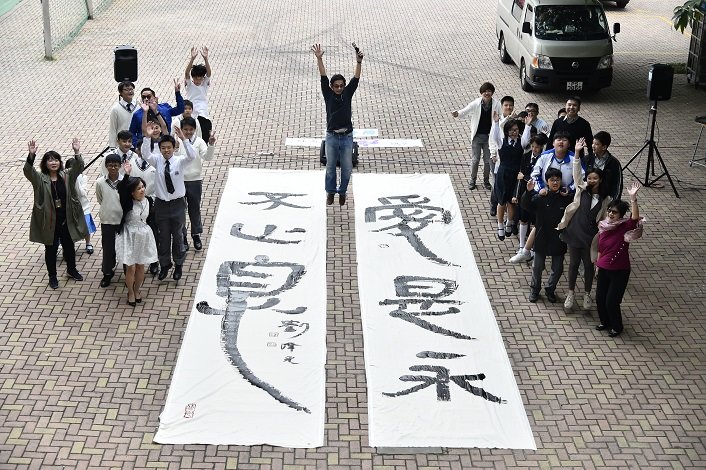Discover HKBU
Dr Daniel Lau: An unconventional calligrapher and Chinese art historian
29 Apr 2021
If you happen to walk past a spectacular ocean scene in Hong Kong only to see someone wielding a brush and splashing ink on a piece of canvas stretched over a rock, then it's very likely to be Dr Daniel Lau, Associate Professor and Associate Director (Research) of the Academy of Visual Arts.
Dr Lau is keen on Chinese culture, and he has a particular interest in Chinese calligraphy and seal engraving. A devout Christian, his calligraphic works cover Bible verses as well as Confucianism and Taoism. For example, he once shared with young people the verses of "Love never fails" (Corinthians 13:8), which is widely known as the "love chapter". He has also performed calligraphy at the invitation of a large-scale religious event, and the invite led to the creation of a grand calligraphic work, God's Love to Hong Kong. Dr Lau is also a nature lover, and he strives to create a perfect harmony between calligraphy and nature. These days, he can often be seen running to the top of hillsides or strolling along seashores with his brushes and ink for calligraphic creation.
He says, "In traditional calligraphy, artworks are of utmost importance. However, in terms of the creation of large calligraphic pieces in a natural setting, the focus is on the creative process. This was the case with the location and the contents of a calligraphic piece that featured God's words Lift My Eyes to the Hills. The message is expressed through the calligrapher's body as they move in harmony with the outdoor environment. With the support of aerial drone videography and photography, this kind of calligraphic performance is entirely different from those traditional pieces done indoors."
Promoting calligraphy through outdoor performances
In 2012, Dr Lau decided to move his calligraphy outdoors and onto a grander stage. Through large-scale outdoor calligraphy performances, he has promoted the traditional art form as well as Chinese history and culture. Examples include a calligraphy performance and workshop entitled "Tapping the Metropolis Rhythm: Whole-body Rendition of Chinese Calligraphy", which took place in December 2016 at the invitation of the Hong Kong Museum of Art. He also conducted a large-scale Chinese calligraphy performance to commemorate the 100th Anniversary of the May Fourth Movement at the Dr Sun Yat-sen Museum in 2019, with the special show incorporating two-dimensional calligraphy into an interactive performing arts recital for the public.
Dr Lau started out on his calligraphy journey while in secondary school, and he learnt the art form under the tutelage of two famous masters of calligraphy, Mr Tsang Kwong-choi and Mr Han Yunshan. Apart from calligraphy, he also loves seal engraving. Dr Lau thinks both art forms emphasise the release of individual inner emotions and the recurrence of individual states. He says, "It is the resilient nature of brushes that creates light and heavy rhythms in sync with thin and thick brushstrokes. Initiated by human thoughts, such rhythms in turn trigger body motions and hand movements, revealing why words can reflect personalities to a certain extent."
Besides Chinese art, Dr Lau also created works in a vast array of Western artforms with a variety of different techniques, such as painting, sketching, sculpture and printmaking, when he was at university. "Eastern and Western art forms are truly abundant. As I pursued my studies in the Department of Art and Architecture at University of California, Santa Barbara, US, I also acquired knowledge about architecture on top of an art history study, for example, the architecture of Western churches and Chinese temples, among others."
Creation based on research
In the arts sector, Dr Lau is among a small pool of calligraphers who have created their works based on scholarly research. He studied art history at university and his MPhil dissertation covered a less popular subject – calligraphy theory. Dr Lau carried out research on Guang Yizhou Shuangji (Extension of the Paired Oars for the Boat of Art), an influential calligraphy treatise written by Kang Youwei, a well-known calligrapher. Thereafter he pursued his PhD in the United States and studied the identity of the Hangzhou artist Ding Jing and the Eight Masters of Xiling in the 18th century.
Following his return to Hong Kong, Dr Lau has continued to combine the creation of art with theoretical study, and he aspires to enrich his artworks through his research. This approach not only reflects his personal and artistic values, but it also reveals the hidden cultural significance of his artworks. For example, in 2010 he created a calligraphic work with the theme "Harmony" that embraced the studies of the Chinese character for "he". He has received funds for a number of research projects, including the exploration of Chinese calligraphy in 20th century Hong Kong from a cultural, social, and economic perspective, and he is also examining the social and cultural implications of Chinese calligraphy in Hong Kong public venues. In addition, Dr Lau has published a wealth of publications related to Chinese calligraphy and seal engraving, including an interdisciplinary project on art creation and theoretical research titled "The Refreshing Paradox of Embracing Innovation for a Return to Antiquity: An Interdisciplinary Approach to Integration of Art Historical Research with Creative Art Practice of Chinese Calligraphy".
Combined with Dr Lau's expansive and innovative approach to Chinese calligraphy, these publications and projects will enrich people's understanding of the art form and pass its secrets on to the next generation.


